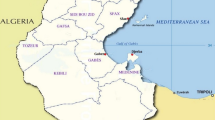Abstract
Populations of Meconopsis paniculata and M. sinuata inhabit open alpine slopes, while those of M. simplicifolia are restricted to alpine meadows of Sikkim Himalaya. These species are threatened and represented by very small populations. Three enzymes namely acid phosphatase, esterase, and glutamate dehydrogenase were tested for six populations each of M. paniculata and M. simplicifolia and single population of M. sinuata to analyse the genetic diversity of these species. In addition, alkaline phosphatases, glucose 6-phosphate dehydrogenase and malate dehydrogenase were tested for M. paniculata populations. The results on the electrophoretic variations revealed that genetic polymorphism is low to absent in all the populations of the three species of Meconopsis investigated, and the species are characterized by genetic homogeneity with fixed alleles.
Similar content being viewed by others
References
Bradford, M.M., 1976. A rapid and sensitive method for quantitation of microgram quantities of proteins utilizing the principle of protein dye-binding. Anal. Biochem. 72: 248–254.
Brown, A.H.D., 1978. Isozymes, plant population genetic structure and genetic conservation. Theoret. Appl. Genet. 52: 145–157.
Brown, A.H.D., 1979. Enzyme polymorphism in plant populations. Theoret. Population Biol. 15: 1–42.
Brown, A.H.D. & G.F. Moran, 1981. Isozymes and genetic resources of forest trees. In: M.T. Conkle (Ed.), Isozymes of North American Forest Trees and Forest Insects, pp. 1–10. U.S. Department of Agriculture, Berkeley.
Brown, A.H.D., E. Nevo, D. Zohary & O. Dagan, 1978. Genetic variation in natural populations of wild barley (Hordeum spontaneum). Genetica 49: 97–108.
Cooper, T.G. 1977. The Tools of Biochemistry, pp. 227, Wiley, New York.
Crisp, M.D. 1988. Eucalyptus recurva (Myrtaceae), a new species from the Southern Tablelands of New South Wales. Telopea 3: 223–230.
Davis, B.J., 1964. Disc electrophoresis' II. Methods and application to human serum proteins. Annu. Rev. N. Y. Acad. Sci. 121: 404–427.
Debnath, H.S. & M.P. Nayar, 1986. The Poppies of Indian Region (Papaveraceae). Botanical Survey of India, Calcutta.
Fowler, D.P. & R.W. Morris, 1977. Genetic diversity in red pine. Evidence for low heterozygosity. Can. J. Forest Res. 7: 341–347.
Hartmann, T., M. Nagel & H.I. Ilert, 1973. Organ specific multiple forms of glutamic dehydrogenase in Medicago sativa. Planta 111: 119–128.
Karron, J.D., Y.B. Linhart, C.A. Chaulk & C.A. Robertson, 1988. Genetic structure of populations of geographically restricted and widespread species of Astragalus (Gabaceae). Amer. J. Botany 75: 1114–1119.
Ledig, F.T. & M.T. Conkle, 1983. Gene diversity and genetic structure in a narrow endemic, Torrey pine (Pinus torreyana Parry ex Car). Evolution 37: 79–85.
Lundkvist, K. & D. Rudin, 1977. Genetic variation in eleven population of Picea abies as determined by isozyme analysis. Hereditas 85: 67–74.
McClenaghan, L.R. & A.C. Beauchamp, 1986. Low genetic differentiation among isolated populations of the Californian fan Palm (Washingtonia filifera). Evolution 40: 315–322.
Moran, G.F. & S.D. Hopper, 1987. Conservation of the genetic resources of rare and widespread eucalyptus in remnant vegetation. In D.A. Saunders, G.W. Arnold, A.A. Burbidge & A.J.M. Hopkins (Eds.), pp. 151–162, Nature Conservation: The Role of Remnant Vegetation, Surrey Beatty and Sons, NSW.
Moran, G.F., Muona, O. & J.C. Bell, 1989. Acacia mangium: a tropical forest tree of the coastal lowlands with low genetic diversity. Evolution 43: 231–235.
Nei, M., 1972. Genetic distance between populations. Amer. Naturalist 106: 283–292.
Poverene, M.M. & N.R. Curvetto, 1989. Esterase isozyme variation in the Eragrostis curvula complex (Poaceae). Plant Systematics and Evolution 166: 173–181.
Prober, S.M., C. Tompkins, G.F. Moran & J.C. Bell, 1990. The conservation genetics of Eucalyptus paliformis L. Johnson et Blaxell and E. parvifolia Cambage, Two rare species from Southeastern Australia. Austral. J. Botany 38: 79–95.
Sampson, J.F., S.D. Hopper & S.H. James, 1988. Genetic diversity and the conservation of Eucalyptus crucis Maiden. Austral. J. Botany 36: 447–460.
Scandalios, J.G., 1969. Genetic control of multiple molecular forms of enzymes in plants. A review. Biochem. Genet. 3: 37–79.
Scandalios, J.G., 1979. Control of Gene Expression and Enzyme Differentiation, pp. 63–107. Physiological Genetics. Academic Press, New York.
Schwaegerle, K.E. & B.A. Schaal, 1979. Genetic variability and founder effect in the pitcher plant Sarracenia purpurea. Evolution 36: 361–370.
Sing, C.F. & G.J. Brewer, 1969. Isozymes of polyploid series of wheat. Genetics 61: 391–398.
Sulaiman, I.M., 1992. Conservation Biological Studies on Meconopsis Vig. Species Populations. Ph.D. Thesis, University of Delhi, Delhi, India.
Sulaiman, I.M., 1993. Seed germination studies in three species of threatened, ornamental, Himalayan poppy, Meconopsis Vig. (Papaveraceae). Seed Science and Technology 21: 593–603.
Sulaiman, I.M., 1994. Regeneration of plantlets through organogenesis in the Himalayan yellow poppy, Meconopsis paniculata. Plant Cell Tissue and Organ Culture 36: 377–380.
Sulaiman, I.M. & C.R. Babu, 1993. In vitro regeneration through organogenesis of Meconopsis simplicifolia — An endangered ornamental species. Plant Cell Tissue and Organ Culture 34: 295–298.
Sulaiman, I.M., N.S. Rangaswamy & C.R. Babu, 1991. Formation of plantlets through somatic embryogeny in the Himalayan blue poppy, Meconopsis simplicifolia (Papaveraceae). Plant Cell Reports 9: 582–585.
Tostain, S. & L. Marchais, 1989. Enzyme diversity in pearl millet (Pennisetum glaucum), 2. Africa and India. Theoret. Appl. Genet. 77: 634–640.
Waller, D.M., D.M. O'Malley & S.C. Gawler, 1987. Genetic variation in the extreme endemic Pedicularis furbishiae (Scrophulariaceae). Conservation Biol. 1: 335–340.
Author information
Authors and Affiliations
Rights and permissions
About this article
Cite this article
Sulaiman, I.M., Babu, C.R. Enzyme polymorphism analyses in three endangered species of Himalayan poppy, Meconopsis (Papaveraceae). Genet Resour Crop Evol 43, 351–356 (1996). https://doi.org/10.1007/BF00132955
Received:
Accepted:
Issue Date:
DOI: https://doi.org/10.1007/BF00132955




